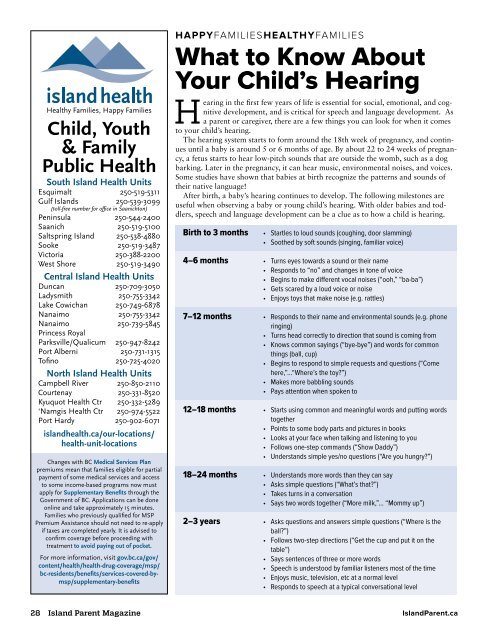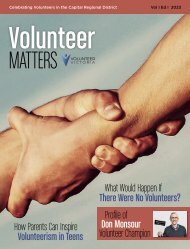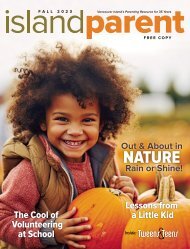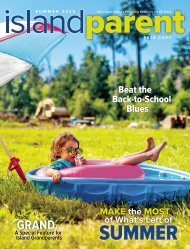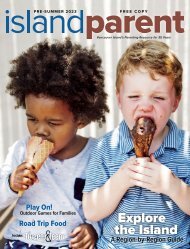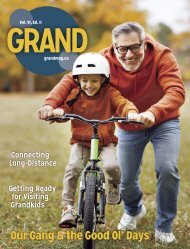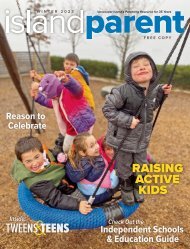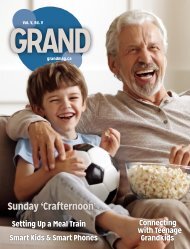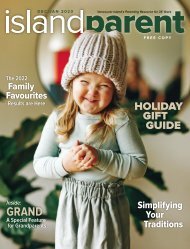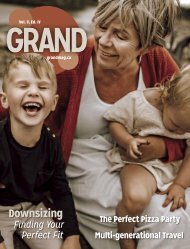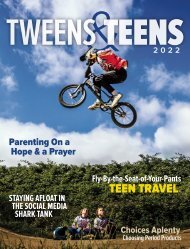Island Parent December 2020 / January 2021
Victoria & Vancouver Island Parenting Magazine Top Toys • How to Celebrate the Small Things • 3 Tips to Reduce Stress
Victoria & Vancouver Island Parenting Magazine
Top Toys • How to Celebrate the Small Things • 3 Tips to Reduce Stress
You also want an ePaper? Increase the reach of your titles
YUMPU automatically turns print PDFs into web optimized ePapers that Google loves.
Healthy Families, Happy Families<br />
Child, Youth<br />
& Family<br />
Public Health<br />
South <strong>Island</strong> Health Units<br />
Esquimalt 250-519-5311<br />
Gulf <strong>Island</strong>s 250-539-3099<br />
(toll-free number for office in Saanichton)<br />
Peninsula 250-544-2400<br />
Saanich 250-519-5100<br />
Saltspring <strong>Island</strong> 250-538-4880<br />
Sooke 250-519-3487<br />
Victoria 250-388-2200<br />
West Shore 250-519-3490<br />
Central <strong>Island</strong> Health Units<br />
Duncan 250-709-3050<br />
Ladysmith 250-755-3342<br />
Lake Cowichan 250-749-6878<br />
Nanaimo 250-755-3342<br />
Nanaimo 250-739-5845<br />
Princess Royal<br />
Parksville/Qualicum 250-947-8242<br />
Port Alberni 250-731-1315<br />
Tofino 250-725-4020<br />
North <strong>Island</strong> Health Units<br />
Campbell River 250-850-2110<br />
Courtenay 250-331-8520<br />
Kyuquot Health Ctr 250-332-5289<br />
‘Namgis Health Ctr 250-974-5522<br />
Port Hardy 250-902-6071<br />
islandhealth.ca/our-locations/<br />
health-unit-locations<br />
Changes with BC Medical Services Plan<br />
premiums mean that families eligible for partial<br />
payment of some medical services and access<br />
to some income-based programs now must<br />
apply for Supplementary Benefits through the<br />
Government of BC. Applications can be done<br />
online and take approximately 15 minutes.<br />
Families who previously qualified for MSP<br />
Premium Assistance should not need to re-apply<br />
if taxes are completed yearly. It is advised to<br />
confirm coverage before proceeding with<br />
treatment to avoid paying out of pocket.<br />
For more information, visit gov.bc.ca/gov/<br />
content/health/health-drug-coverage/msp/<br />
bc-residents/benefits/services-covered-bymsp/supplementary-benefits<br />
HAPPYFAMILIESHEALTHYFAMILIES<br />
What to Know About<br />
Your Child’s Hearing<br />
Hearing in the first few years of life is essential for social, emotional, and cognitive<br />
development, and is critical for speech and language development. As<br />
a parent or caregiver, there are a few things you can look for when it comes<br />
to your child’s hearing.<br />
The hearing system starts to form around the 18th week of pregnancy, and continues<br />
until a baby is around 5 or 6 months of age. By about 22 to 24 weeks of pregnancy,<br />
a fetus starts to hear low-pitch sounds that are outside the womb, such as a dog<br />
barking. Later in the pregnancy, it can hear music, environmental noises, and voices.<br />
Some studies have shown that babies at birth recognize the patterns and sounds of<br />
their native language!<br />
After birth, a baby’s hearing continues to develop. The following milestones are<br />
useful when observing a baby or young child’s hearing. With older babies and toddlers,<br />
speech and language development can be a clue as to how a child is hearing.<br />
Birth to 3 months<br />
4–6 months<br />
7–12 months<br />
12–18 months<br />
18–24 months<br />
2–3 years<br />
• Startles to loud sounds (coughing, door slamming)<br />
• Soothed by soft sounds (singing, familiar voice)<br />
• Turns eyes towards a sound or their name<br />
• Responds to “no” and changes in tone of voice<br />
• Begins to make different vocal noises (“ooh,” “ba-ba”)<br />
• Gets scared by a loud voice or noise<br />
• Enjoys toys that make noise (e.g. rattles)<br />
• Responds to their name and environmental sounds (e.g. phone<br />
ringing)<br />
• Turns head correctly to direction that sound is coming from<br />
• Knows common sayings (“bye-bye”) and words for common<br />
things (ball, cup)<br />
• Begins to respond to simple requests and questions (“Come<br />
here,”…“Where’s the toy?”)<br />
• Makes more babbling sounds<br />
• Pays attention when spoken to<br />
• Starts using common and meaningful words and putting words<br />
together<br />
• Points to some body parts and pictures in books<br />
• Looks at your face when talking and listening to you<br />
• Follows one-step commands (“Show Daddy”)<br />
• Understands simple yes/no questions (“Are you hungry?”)<br />
• Understands more words than they can say<br />
• Asks simple questions (“What’s that?”)<br />
• Takes turns in a conversation<br />
• Says two words together (“More milk,”… “Mommy up”)<br />
• Asks questions and answers simple questions (“Where is the<br />
ball?”)<br />
• Follows two-step directions (“Get the cup and put it on the<br />
table”)<br />
• Says sentences of three or more words<br />
• Speech is understood by familiar listeners most of the time<br />
• Enjoys music, television, etc at a normal level<br />
• Responds to speech at a typical conversational level<br />
28 <strong>Island</strong> <strong>Parent</strong> Magazine <strong>Island</strong><strong>Parent</strong>.ca


